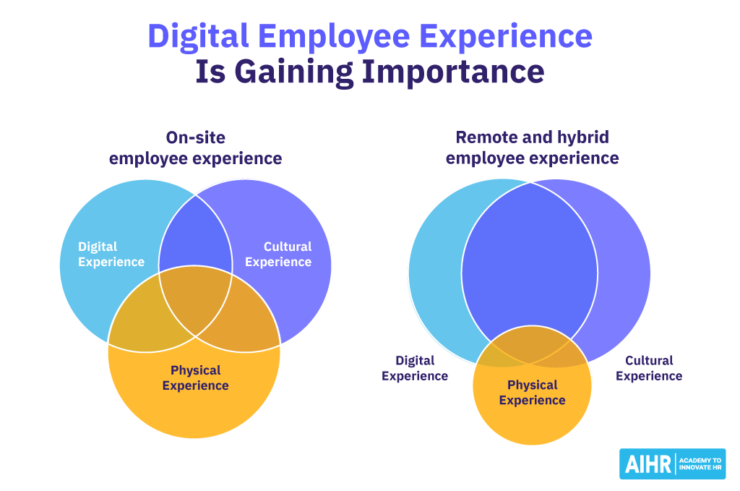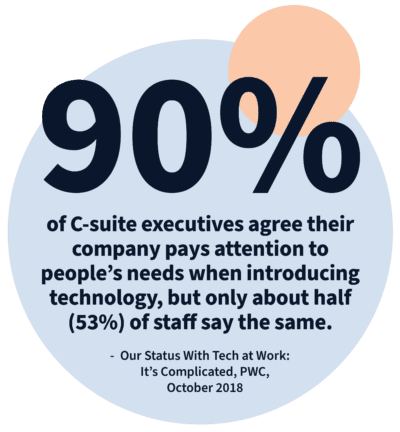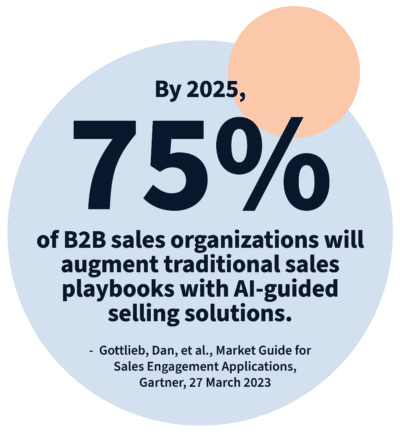What is digital employee experience?
Think of your office as your wheelhouse — a place that’s organized specifically to suit your preferences and workflows that allows you to tackle each day’s responsibilities confidently and efficiently. Chances are technology — the kind that’s intuitive, usable, and capable of streamlining the tasks you’re expected to perform every day — plays a starring role in this vision. And just like that, you’ve stumbled on the essence of digital employee experience.
Here’s a look at some of the specific elements that play a critical role in digital employee experience:
- Technology quality, performance, and relevance. Simply purchasing the “latest and greatest” technology doesn’t ensure it’s a match for the needs of your enterprise. To ensure ROI it’s vital to purchase proven, high-quality solutions that address the needs of your client advisors and sales teams — and perform the tasks necessary to enhance their job performance.
- User interface (UI) design. Advisors and sales teams will only tap the potential of your technology investments if the UI ensures ease-of-use — and delivers real job performance benefits. Without good UI, user experience (UX) and adoption will fall short.
- Technology integration. To ensure the best UX, sales enablement technologies must effectively integrate with existing enterprise systems like CRM and communications platforms. AI-enhanced revenue operations platforms can significantly enhance integration performance and usability.
- Experience personalization and customization. To leverage the unique capabilities and working styles of advisors and sales team members, the ability to personalize user experience is essential. Strong personalization and customization capabilities also enhance the ability of users to collaborate with teams and departments throughout the enterprise to improve customer experience and engagement outcomes.
- Employee training and ongoing support. Intuitive UI goes a long way toward helping sales teams and advisors to quickly ascend the learning curve — but ongoing training and support ensure that users understand technology potentials, and embrace proven best practices.
Today, with sales teams and client advisors managing remote work arrangements, growing customer and prospect rosters, and relying on enormous quantities of customer data, employers’ efforts to continually improve universally-accessible digital employee experience are more important than ever.
Why does digital employee experience matter?
“Technology will make our lives easier.” Like a popular song that ultimately suffers the cruel fate of being relentlessly overplayed, this technology promise is one we’ve heard so often and for so long that we simply tune it out. So when your employer announces new process and technology investments designed to improve employee experience, you’re forgiven for your lack of enthusiasm: you’ve heard it many times before — but the reality often falls short of the promise.
Fortunately, smart enterprises recognize the importance of making — and continually demonstrating — a strong commitment to providing and improving digital customer experience. From the enterprise perspective, it boils down to enlightened self-interest. By enhancing digital customer experience through thoughtful investment in technologies that improve data quality, customer 360, transparency, and security, businesses boost the kind of employee efficiency, productivity, and retention that improves customer experience to boost customer lifetime value and revenue growth.
That’s why digital employee experience matters.

How can you improve your digital employee experience?
Given the sophistication and complexity of the work today’s client advisors and sales teams do, it’s no surprise that the pursuit of exceptional digital customer experience involves lots of moving parts. And while there’s no simple, singular, quick-fix answer for the challenges that can slow digital customer experience improvement, there are a number of straightforward steps that can accelerate those efforts — and boost the satisfaction of your sales teams and the customers they serve.

1. Invest in the right technology
All too often, enterprises invest in technologies that are long on promises — but short on real-world utility. Over time, sales teams and advisors learn to work around, not with, these niche solutions because they don’t improve digital employee experience. In many cases, they add clutter to workflows, often requiring steep learning curves while providing little or no productivity or performance benefit to the teams expected to use them. From employee frustration to increasing technology debt, investments in the wrong technologies are often more damaging to workforce performance and morale than no investment at all.
Investments in the right relationship management and revenue operations data integration technologies, however, can bring transformative impacts on both worker productivity and satisfaction. The key, of course, is to know what those technologies are.
The best starting point? Consider and collaborate with the teams who’ll use the technologies to better understand their experience. Choose solutions like Riva that work behind the scenes and within the CRM, email, and calendar platforms advisors and sellers already know and use — surfacing essential customer data when and where it’s most useful. By unifying and governing data, improving its quality, and ensuring its security, solutions like Riva help enterprises to realize the power of CRM as a single source of truth — further amplifying its utility to sellers and advisors.
It’s also important to invest in your “Seller Action Hub” by choosing proven and complementary technologies that aggregate the power of revenue data, conversation intelligence, revenue intelligence, sales engagement apps, and revenue enablement to put high-quality data, analytics, and forecasting at the fingertips of your go-to-market teams — giving them the tools they need to support customer engagement and build customer lifetime value.
2. Demand and sustain high-quality UI to encourage user adoption — and support hybrid selling
“Many companies have embraced a remote or hybrid work model and are sticking with it. A recent State of the Digital Workplace study showed that “mostly or entirely” remote businesses have increased to 13% from 10% in the past year [and the] share of businesses operating in a hybrid environment has been 60%.”
Boatman, Andrea, Digital Employee Experience: a Definitive Guide for 2024, Academy to Innovate HR
While it’s common for technologies to tout exceptional, often specialized capabilities designed to help client advisors and sellers to close sales, development budgets often prioritize power at the expense of UI. Unfortunately, no matter how powerful a technology, sellers simply won’t gravitate toward, much less adopt, a solution with a confounding user interface (UI). Sellers are, after all, consumers — and they’ll only use technologies that are intuitive, effective, and easy to integrate with their current workflows.
As advisor and seller roles become increasingly hybridized, and even completely remote, UI intuitiveness becomes even more important. As workers acclimate to these increasingly remote roles, it’s essential that they perform well in a number of different environments, on a range of platforms — using platforms that don’t frustrate their efforts and precipitate repeat calls to user support for basic operational guidance.
The solution? Choose technologies exhibiting a clear awareness that great tools need great, intuitive interfaces. By choosing well-designed solutions like Riva — which provides sales enablement, relationship, and revenue operations capabilities within platforms like CRM, email, and calendar. By integrating powerful tools in applications users already know, Riva provides in-depth, in-context, real-time access to customer journey data when and where it’s needed — in formats that are easy to understand and easy to navigate. Armed with that data, client advisors and sales teams are ideally positioned to build customer relationships and move transactions forward.
3. Leverage AI automation to Integrate technology effectively

Given its expanding impact on nearly every other aspect of business life, it’s no surprise that AI can play a profound role in shaping the future of digital customer experience. From an enterprise perspective, AI’s growing ubiquity signifies the importance of evaluating its role in automating processes that enhance digital employee experience.
One of AI’s most promising advantages is its ability to automate customer data capture and quality improvements that were traditionally relegated to client advisors and sales teams. By implementing AI-enhanced revenue operations data integration technologies like Riva, go-to-market teams are freed from the responsibility of manually transcribing data from one platform to another.
Because AI can process and rectify enormous quantities of traditionally siloed customer data gathered through multiple applications across the enterprise, it can be tasked to eliminate manual data capture errors, omissions, and redundancies. This process helps to continually improve data quality and enhance data security — while concurrently governing data distribution to client advisors and sales teams via single-source-of-truth CRM. These automated processes ultimately improve digital employee experience by eliminating time-consuming data entry tasks, and providing current, comprehensive customer data in real-time, when and where it’s needed to cultivate strong customer relationships and build customer lifetime value.
4. Prioritize personalized, customizable user experience to leverage individual working styles and strengths — and encourage interdepartmental collaboration
“Companies with a focus on creating a great employee experience had a 50% higher rate of revenue growth and a 50% higher rate of profit growth than companies that did not prioritize it.”
Davydova, Polina, Elevating Digital Employee Experience (DEX): a Critical Priority for Business Success, Microsoft, 18 April 2023, citing The Employee Experience Advantage by Jacob Morgan
One of the more ironic benefits of today’s AI-enhanced technologies is their ability to leverage the individual strengths of client advisors and sales team members. Rather than boxing users into rigidly-prescribed sales engagement patterns, technologies like Riva give workers the power to personalize the customer engagement process by creating and distributing communications tailored to each customer’s unique needs.
Using technologies like Riva, go-to-market team members have the power to leverage AI’s large language model content generation capabilities to create tailored communications — and to make that information available via the channels customers prefer. Using these powerful, intuitive technologies, advisors and sales teams can sustain customer relationships and advance revenue opportunities between in-person communications, ultimately transforming each rep’s engagement potential from 1:1 to 1:many. From a digital employee experience perspective, this enhances job performance and satisfaction by boosting results — without increasing workload.
5. Provide training and support necessary to support performance and success
Yes. It’s called digital employee experience. But the success of digital employee experience is still a very human endeavor — one that requires a sustained, enterprise-wide commitment to ongoing training and support.
All too often, however, enterprises fall into training and support complacency — caused in no small part by promises that new technologies are sufficiently intuitive to support plug-and-play adoption. But it’s critical to remember that advisors and sales teams are creatures of habit who fall into everyday routines, repeatedly relying on the same tools and techniques to achieve predictable ends.
That’s why it’s critical for enterprises to approach technology selection and investment with clear implementation and maintenance plans that anticipate the need to educate and incentivize end-user adoption. From a resource standpoint, training and support initiatives often represent low investments relative to technology costs. And while the ongoing commitment to those efforts requires diligence, the ROI — as measured by both employee and customer experience — is enormous.
Continually improve digital employee experience
When your business relies on client advisors and sales teams to satisfy steadily elevating customer expectations, commitment to high-quality digital customer experience is essential. From increasing job satisfaction and productivity to enhancing customer relationships and lifetime value, the embrace of technologies, practices, and training to improve digital employee experience promises greater returns than nearly any enterprise investment.
Working with Riva’s proven, AI-enhanced revenue operations, relationship management, and sales enablement solutions, your enterprise can accelerate efforts to continually improve digital employee experience — and to leverage its potential to improve data quality, boost sales performance, and grow bottom-line performance. We encourage you to contact us for a live demo.
- Guide to Einstein Activity Capture: All You Need to Know
- 2024 Bankers Summit: 5 Key Takeaways
- Financial Services: Mastering Customer 360 and Client Engagement for Increased Customer Lifetime Value
- Dreaming Big at Salesforce Education Summit San Diego 2024
- How to Build a Sales Cadence in 2024: Examples and Best Practices
